The Wire
Ever wondered how sports pages carried up to date images from races from all over the world before digital cameras and the internet were invented? They did it by wire.
Words: Chris Sidwells
Photos: AP Wirephoto
The images were called wire photos, and they came down telephone wires in newspaper and magazine offices. They weren’t always top quality, but wire photos had a wonderful immediacy then, and their grainy nature adds a patina of romance now.
Imagine working in the office. It’s Sunday night and the on-the-spot journo has dictated his report down the telephone. The words are laid out, but they need images to bring them to life. Suddenly the cumbersome wire-photo machine creaks into life and a black and white image slowly emerges, still wet and smelling of chemicals. There’s the winner, the crash, the action right from the heart of the biggest races, and you are first to see it.
Wire photographs originated in North America, the Western Union transmitted its first halftone photograph in 1946. The Associated Press, where these wire photos are from, ran its AP Wirephoto service between 1963 and 2004.
Wire photo technology was expensive at first, the first machines were very bulky and required special phone lines, but later portable wire machines could transmit and receive using normal phone lines.
Dan Jarvis gave me the photos of Tom Simpson shown here, explaining; “My grandfather John Jarvis worked at the Guardian newspaper, and he rescued the photos from the ‘not being used bin’ for my father, Ray who was a keen racing cyclist and still rides. He (Ray) travelled out to San Sebastian to see the 1965 world championships with friends, and was privileged to see Tom win the world title.”
They are good examples of what came down the wire, although as Dan Jarvis says these weren’t quite good enough to make it into the paper. Each photo has an awkward AP caption, but the basic information in it is correct. The photos are from random moments in Simpson’s career, and they serve to introduce Cycling Legends 01 Tom Simpson, the first in the series of Cycling Legends illustrated books, which will be published shortly.
The book is full of rarely seen and previously un-published photos of Tom. These wire photos didn’t pass the high standards we want for the Cycling Legends series, so I’m using them here. Still, they provide a nice window on how things were done, as well as show some happy and one very sad moment from Tom Simpson’s career. It’s the first time they have ever been published too.
05/09/1965 Hernani Hill, San Sebastian, Spain
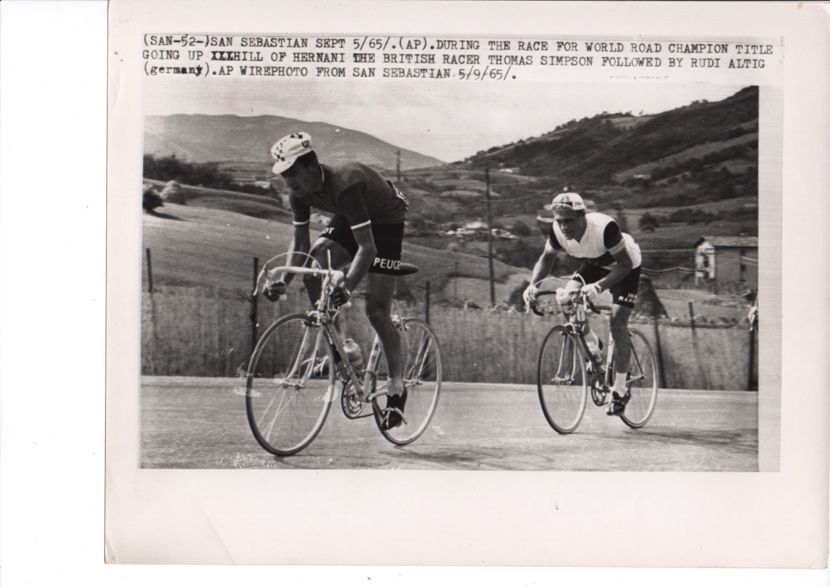
This is the last lap of the 1965 world professional road race championships. Simpson is leading Rudi Altig of Germany, and they won’t be caught. Two laps before Simpson used this climb to attack the leading group, riding its entire length in 54x14. Altig was the only one who could follow.
05/09/1965 Lasarte, San Sebastian, Spain
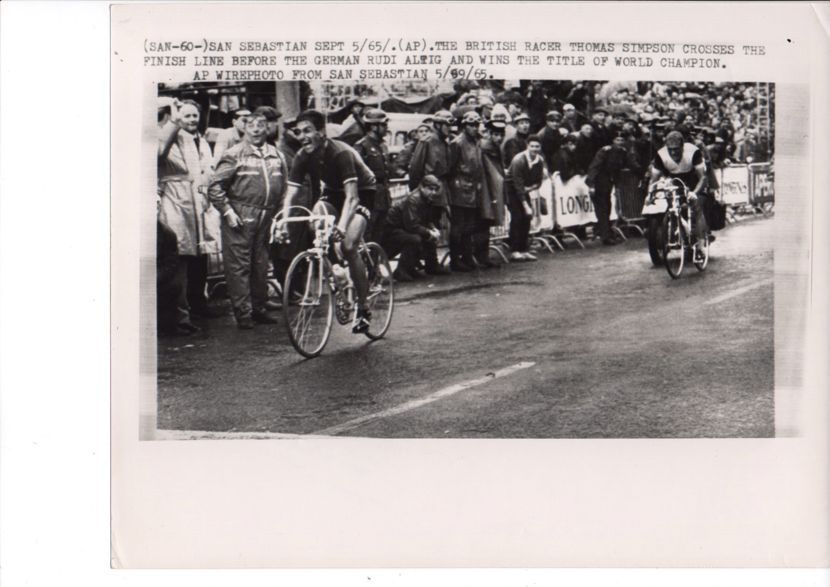
Crossing the finish line well clear of Altig, Simpson realises he is world champion, the first British rider ever to win the pro road race title. Only Mark Cavendish has won it since.

Crossing the finish line well clear of Altig, Simpson realises he is world champion, the first British rider ever to win the pro road race title. Only Mark Cavendish has won it since.
05/09/1965 Lasarte, San Sebastian, Spain

“We agreed to work together until one kilometre to go, then we would decide the race,” Altig said afterwards. But as Altig moved over to take his side of the road, Simpson attacked as hard as he could.
He got a gap, shifted into a higher gear, put his head down and went for it. Altig was taken by surprise, he hesitated, then it took a while to get on top of the gear he was in, then his legs buckled. “I fractured my hip earlier in the year and I was short of training and competition,” he explained.
Simpson described the last moments of the race like this; “When I looked down I could see Altig’s reflection in the wet road and I kept thinking he’s coming, he’s coming. Then, suddenly, the finish line flashed beneath me and I thought he hasn’t come past, I’ve won; I’m the world champion.”
05/09/1965 Lasarte, San Sebastian, Spain
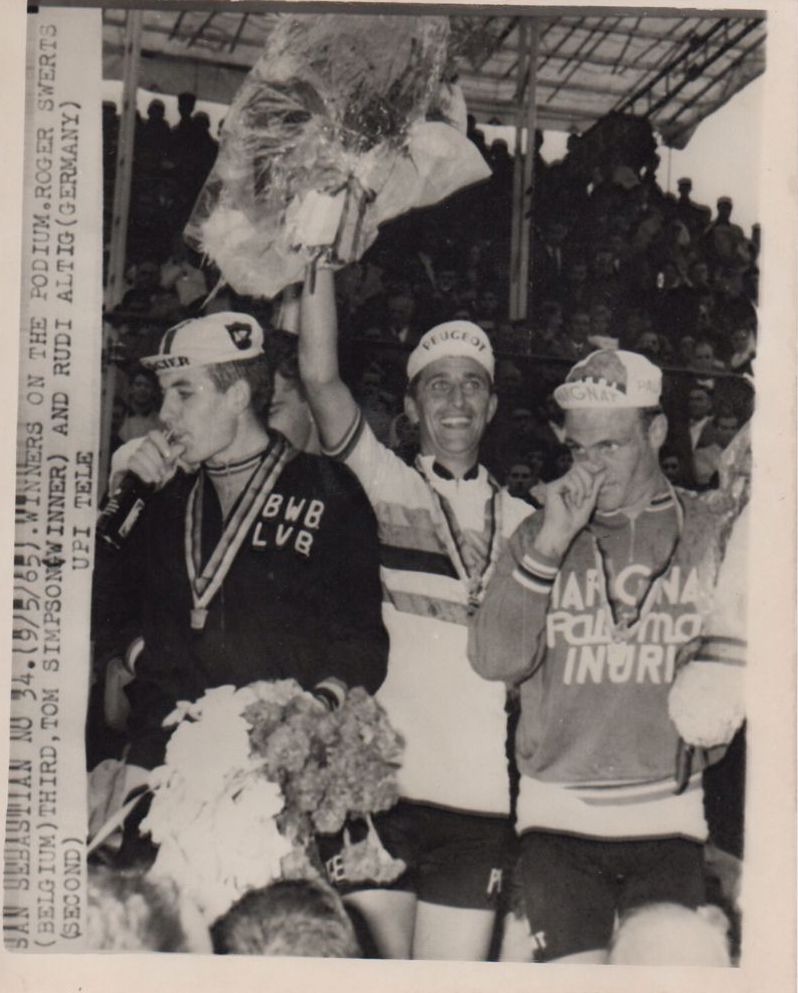
The podium, and you can see why this photo wasn’t used next day. Simpson, full of joy in his rainbow jersey, is flanked by third place Roger Swerts (left), who as a true Belgian swigs from a bottle of beer, while Rudi Altig seems to have taken a moment to ‘adjust’ his nose.
16/10/1965 Como, Italy
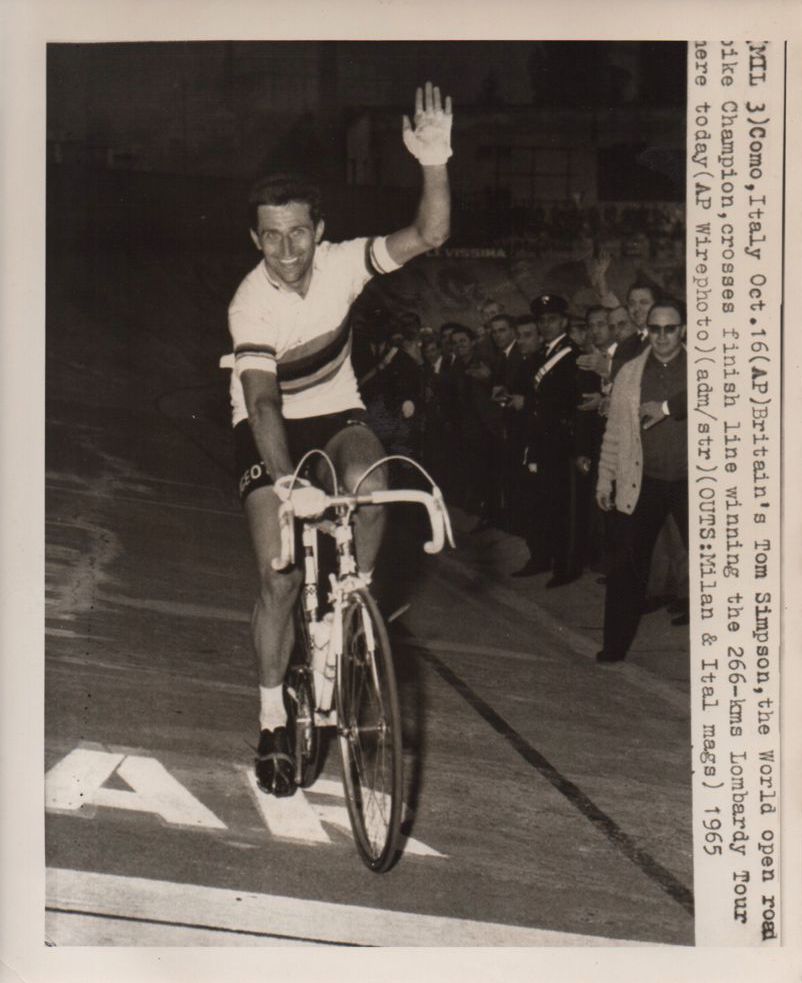
The caption on this one is special; “Tom Simpson, the world open road bike champion.” AP caption writers were English, and unless they were active cyclists they would know little about what was a minority sport in the UK back then.
Earlier in 1965 Simpson had taken part in the London to Holyhead single-day race, which because it was very long started very early in the morning. The night before, Simpson stayed in a posh hotel, and as arranged was woken by the concierge, who told him; “It’s time to get up for your cycle rally sir.”
In this photo Tom is about to cross the finish line to win his third monument, Il Lombardia, or the Giro di Lombardia as it was called then. Some say it was his greatest victory, and it’s true that he simply rode away from the rest, winning alone by 3 minutes and 11 seconds. Next day La Gazzetta dello Sport said “Simpson won in the manner of Coppi.”
Fausto Coppi was Tom’s childhood hero, he was even nicknamed the Four-stone Coppi by his Harworth and District Cycling Club mates, and in 1965 Coppi was still the best cyclist the world had ever seen. It was a massive compliment.
1967 Nice, France

Simpson has just become the first British winner of Paris-Nice, which reflected a change of attitude in 1967. With a world title, three monuments and top five in every classic, Simpson still has a far better record in single-day races than any other British rider by far. But in 1967 he was going for a podium place at least, and victory if possible, in the Tour de France.
He’d already finished sixth in the 1962 Tour, and but for a crash with three days to go when he was third overall he might have had a podium then. The ability to do it was there, and he was determined to be the best he could be for the 1967 Tour. The classics were put on the back-burner, Simpson would focus on stage races. Winning Paris-Nice was his first step towards his Tour de France goal.

“We agreed to work together until one kilometre to go, then we would decide the race,” Altig said afterwards. But as Altig moved over to take his side of the road, Simpson attacked as hard as he could.
He got a gap, shifted into a higher gear, put his head down and went for it. Altig was taken by surprise, he hesitated, then it took a while to get on top of the gear he was in, then his legs buckled. “I fractured my hip earlier in the year and I was short of training and competition,” he explained.
Simpson described the last moments of the race like this; “When I looked down I could see Altig’s reflection in the wet road and I kept thinking he’s coming, he’s coming. Then, suddenly, the finish line flashed beneath me and I thought he hasn’t come past, I’ve won; I’m the world champion.”
05/09/1965 Lasarte, San Sebastian, Spain

The podium, and you can see why this photo wasn’t used next day. Simpson, full of joy in his rainbow jersey, is flanked by third place Roger Swerts (left), who as a true Belgian swigs from a bottle of beer, while Rudi Altig seems to have taken a moment to ‘adjust’ his nose.
16/10/1965 Como, Italy

The caption on this one is special; “Tom Simpson, the world open road bike champion.” AP caption writers were English, and unless they were active cyclists they would know little about what was a minority sport in the UK back then.
Earlier in 1965 Simpson had taken part in the London to Holyhead single-day race, which because it was very long started very early in the morning. The night before, Simpson stayed in a posh hotel, and as arranged was woken by the concierge, who told him; “It’s time to get up for your cycle rally sir.”
In this photo Tom is about to cross the finish line to win his third monument, Il Lombardia, or the Giro di Lombardia as it was called then. Some say it was his greatest victory, and it’s true that he simply rode away from the rest, winning alone by 3 minutes and 11 seconds. Next day La Gazzetta dello Sport said “Simpson won in the manner of Coppi.”
Fausto Coppi was Tom’s childhood hero, he was even nicknamed the Four-stone Coppi by his Harworth and District Cycling Club mates, and in 1965 Coppi was still the best cyclist the world had ever seen. It was a massive compliment.
1967 Nice, France

Simpson has just become the first British winner of Paris-Nice, which reflected a change of attitude in 1967. With a world title, three monuments and top five in every classic, Simpson still has a far better record in single-day races than any other British rider by far. But in 1967 he was going for a podium place at least, and victory if possible, in the Tour de France.
He’d already finished sixth in the 1962 Tour, and but for a crash with three days to go when he was third overall he might have had a podium then. The ability to do it was there, and he was determined to be the best he could be for the 1967 Tour. The classics were put on the back-burner, Simpson would focus on stage races. Winning Paris-Nice was his first step towards his Tour de France goal.
30/04/1967 Astorga, Spain
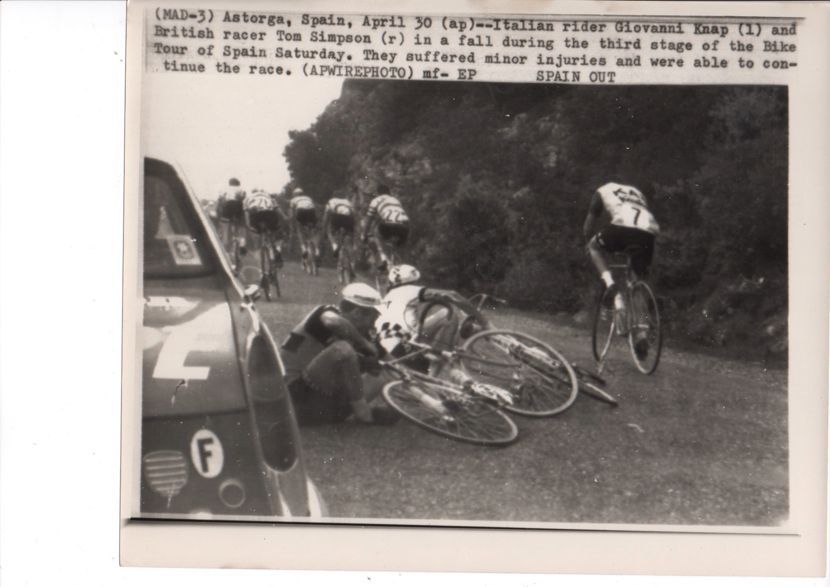
Simpson crashes on stage three of the Vuelta a España. It was his first time in this Grand Tour, and he planned to use the full three weeks as part of his build up for the Tour de France.
The crash meant he missed a break that gained 13 minutes, so any chance of a good overall performance was gone. He felt rough next day, and hadn’t improved much on the eve of stage five, Salamanca to Madrid.

Simpson crashes on stage three of the Vuelta a España. It was his first time in this Grand Tour, and he planned to use the full three weeks as part of his build up for the Tour de France.
The crash meant he missed a break that gained 13 minutes, so any chance of a good overall performance was gone. He felt rough next day, and hadn’t improved much on the eve of stage five, Salamanca to Madrid.
He decided to leave the race, only the fact that he had to fly from Madrid to get home made Simpson start the next day, but he got in a break on the road to Madrid and won the stage. He stuck with the Vuelta after that, winning another stage and coming out of the race with incredible form for the Tour de France.
30/06/1967 Angers, France


The Great Britain team line up at the start of the 1967 Tour de France. They are, left to right; Michael Wright, Tom Simpson, Arthur Metcalfe, Colin Lewis, Bill Lawrie, Barry Hoban, Albert Hitchen, Peter Hill, Vin Denson and Peter Chisman.
The 1967 Tour was contested by national and regional teams for the first time since 1961. The British team wasn’t strong, only Simpson, Hoban, Wight and Denson had ridden the race before, but at least Tom could depend 100 percent on the riders’ support. That hadn’t always been the case with the Peugeot-BP, the team he’d raced for since 1963.
This was a happy time, the way Peugeot negotiated Simpson’s contract each year was scotched by the Tour having national teams, I explain why in Cycling Legends 01. So Tom was leaving Peugeot and moving to the Italian team, Salvarani on much better terms for 1968.
13/07/1967 Carpentras, France
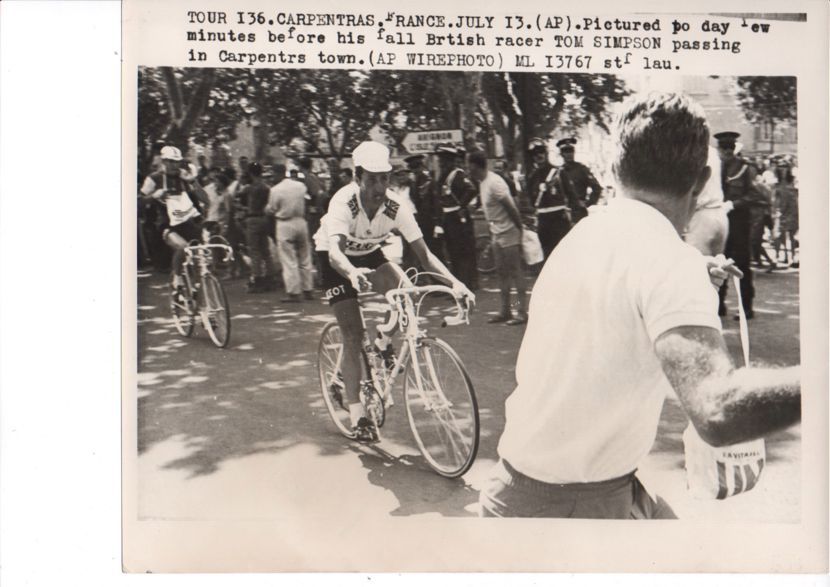

Simpson takes his final musette before pedalling out of Carpentras to Bédoin, at the base of Mont Ventoux. Carpentras was where the stage finished later that day, after the riders did a big loop that included the Ventoux. By the time they arrived, Tom Simpson was dead.
Cycling Legends 01 Tom Simpson
This will be published in early November and will be available to buy from this website, www.cyclinglegends.co.uk using the Cycling Legends Series of Books button on the home page, and from Planet X, www.planetx.co.uk. The books will also be available from other outlets. More details in due course.

This will be published in early November and will be available to buy from this website, www.cyclinglegends.co.uk using the Cycling Legends Series of Books button on the home page, and from Planet X, www.planetx.co.uk. The books will also be available from other outlets. More details in due course.




